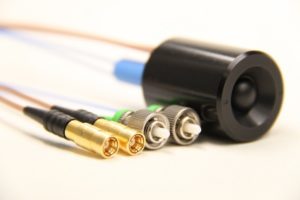 The researchers at Fraunhofer have packaged the transmitting and receiving unit for terahertz radiation into a handy little sensor head with a diameter of only 25 and a length of 35 millimeters.First prototypes are already being used for the production of plastic pipes.
The researchers at Fraunhofer have packaged the transmitting and receiving unit for terahertz radiation into a handy little sensor head with a diameter of only 25 and a length of 35 millimeters.First prototypes are already being used for the production of plastic pipes.
Measuring system with the innovative sensor head
The latest developments of the Fraunhofer Institute for Telecommunication, Heinrich Hertz Institut, HHI in Berlin, could now give terahertz technology a decisive boost. The research team has succeeded in developing terahertz devices that for the first time are made from standard and therefore low-cost components and are also relatively easy to handle. A The principle employed by Fraunhofer HHI for generating terahertz radiation is based on an optoelectronic method. Using a special semiconductor, laser light pulses are converted into electrical terahertz pulses that are only one billionth of a second long.
The reason for the lack of success of the terahertz technology until now is mainly due to the required properties of the semiconductors being used. These could only be achieved with materials that required an illumination with a wavelength of 800 nanometers. Both the terahertz system‘s laser and optical components are too expensive and not robust enough for industrial use when using this rather exotic wavelength.
Commonly used wavelength standard
“Therefore, we have developed a semiconductor that can be stimulated with a laser light centered around a wavelength of 1.5 micrometers,” says Göbel. “In optical communications, this wavelength is standard, which is why there is large number of inexpensive and high-quality optical components and lasers on the market.”
However, one obstacle needed to be overcome on the way to creating an affordable and handy terahertz system for testing materials. Until now, the sensor head for scanning components was too big and heavy for easy handling. The reason: the terahertz transmitter and the receiver were two separate components that had to be mounted in a casing with great effort and precision. The main disadvantage of this arrangement was that samples can only be measured at an angle. Therefore, the object had to be exactly in focus of the transmitter and receiver so that the terahertz signal sent from the transmitter via the sample could be displayed on the receiver. If the distance between the sensor head and the sample changes, for example due to vibrations, it becomes more difficult to measure.
The Fraunhofer HHI experts have solved this problem by manufacturing an integrated chip that can transmit and receive simultaneously. Now it is possible to use a single optical lens that focuses on the object, which allows for a flexible operating distance. The researchers packed this transmitting and receiving unit, the transceiver, into a handy little sensor head with a diameter of only 25 and a length of 35 millimeter. The device will be presented at the Hannover trade fair.
Moreover, these terahertz sensor system prototypes have been in use by manufacturers of plastic pipes for some time now. These sensors are directly used in the production line to monitor the thickness of the pipe walls. Another future application is the verification of paints and coatings on fiber reinforced composite materials.



